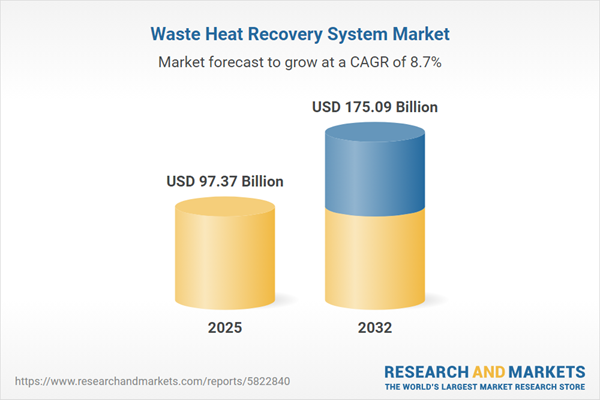Speak directly to the analyst to clarify any post sales queries you may have.
Waste heat recovery systems are transforming how industrial organizations manage energy, offering new avenues for efficiency and sustainable operations. These solutions are central to helping senior decision-makers enhance long-term competitiveness and adapt to regulatory developments.
Market Snapshot: Waste Heat Recovery System Market
The global Waste Heat Recovery System Market is valued at USD 89.68 billion in 2024, projected to reach USD 97.37 billion by 2025 and USD 175.09 billion by 2032. This momentum is being fueled by investments from leading enterprises focused on upgrading energy systems and optimizing industrial processes. As priorities shift toward operational reliability and resource optimization, companies are rapidly adopting these solutions in response to new stakeholder expectations and environmental guidelines. Technological progress, particularly in thermal recovery integration and emissions management, is enabling businesses to align with modern compliance and sustainability standards while realizing cost control benefits.
Scope & Segmentation
- End User Industries: Manufacturers in the cement, chemical, food and beverage, glass, power generation, and steel production sectors are employing recovery technologies to enhance plant efficiency, address regulatory mandates, and meet sustainability objectives.
- Technology Types: Options such as the Kalina Cycle, Organic Rankine Cycle, and Steam Rankine Cycle are being deployed for improved energy extraction, facilitating both equipment upgrades and new site installations.
- Core Components: Condensers, heat exchangers, pumps, and turbines integrate into facility infrastructure to boost conversion efficiency and modernize both existing and greenfield projects.
- Installation Models: Greenfield and retrofit deployment approaches allow for flexible adoption of waste heat recovery capabilities as operational requirements change, supporting business agility.
- Capacity Tiers: Modular and scalable design enables access for a wide range of organizations, accommodating gradual expansion across industries with changing energy demands.
- Regional Coverage: The Americas, Europe, Asia-Pacific, and Middle East and Africa offer diverse compliance environments, supply chain approaches, and technology adoption patterns, requiring regionally tailored integration strategies.
- Key Companies Profiled: Organizations including General Electric Company, Siemens AG, Mitsubishi Heavy Industries, ABB Ltd, Babcock & Wilcox Enterprises, MAN Energy Solutions SE, Alfa Laval Corporate AB, Parker Hannifin Corporation, Caterpillar Inc., and Ansaldo Energia S.p.A. play a pivotal role in shaping market standards, innovation, and technology advancement.
Key Takeaways for Senior Decision-Makers
- Waste heat recovery systems are instrumental for industrial companies striving for sustainability goals and adapting to evolving energy and environmental policy landscapes.
- Advances in thermal cycle technology now support broader applications and extend equipment lifecycles, enhancing versatility and long-term investment returns.
- The integration of IoT-enabled analytics supports predictive maintenance, allowing real-time monitoring to minimize downtime and reduce operational risks.
- Flexible installation and system integration approaches allow organizations to upgrade or expand facilities with minimal operational disruption, supporting uninterrupted productivity.
- Procurement processes are shifting to emphasize ESG criteria, accountable supplier relationships, and sustainable sourcing, which underpin business resilience and corporate reputation.
Tariff Impact on the Waste Heat Recovery System Market
Recent changes in US tariffs have raised costs for key components such as turbines and heat exchangers. In response, industry leaders are increasing reliance on regionalized procurement and strengthening supply chain alliances to maintain reliable operations and mitigate cost volatility driven by trade shifts.
Methodology & Data Sources
Findings in this report are informed by a triangulated research process, combining direct stakeholder interviews and extensive secondary sources, including regulatory documents and expert perspectives. This approach ensures the waste heat recovery system market analysis is actionable and representative of real-world trends.
Why This Report Matters
- Delivers objective insight into the influence of technology innovation and regulatory evolution on waste heat recovery policies and operational strategies for industrial sectors.
- Clarifies the implications of shifting international trade conditions, informing sourcing and procurement strategies within a dynamic global marketplace.
- Supports executive decision-making by enabling benchmarking of suppliers and solution models to enhance efficiency, regulatory compliance, and progress toward sustainability.
Conclusion
The adoption of waste heat recovery systems enables industrial organizations to improve operational efficiency, achieve greater compliance, and expand sustainability efforts. Leaders can approach market changes with clarity and strategic focus.
Additional Product Information:
- Purchase of this report includes 1 year online access with quarterly updates.
- This report can be updated on request. Please contact our Customer Experience team using the Ask a Question widget on our website.
Table of Contents
3. Executive Summary
4. Market Overview
7. Cumulative Impact of Artificial Intelligence 2025
Companies Mentioned
The companies profiled in this Waste Heat Recovery System market report include:- General Electric Company
- Siemens AG
- Mitsubishi Heavy Industries, Ltd.
- ABB Ltd
- Babcock & Wilcox Enterprises, Inc.
- MAN Energy Solutions SE
- Alfa Laval Corporate AB
- Parker Hannifin Corporation
- Caterpillar Inc.
- Ansaldo Energia S.p.A.
Table Information
| Report Attribute | Details |
|---|---|
| No. of Pages | 186 |
| Published | October 2025 |
| Forecast Period | 2025 - 2032 |
| Estimated Market Value ( USD | $ 97.37 Billion |
| Forecasted Market Value ( USD | $ 175.09 Billion |
| Compound Annual Growth Rate | 8.7% |
| Regions Covered | Global |
| No. of Companies Mentioned | 11 |









